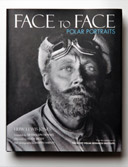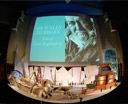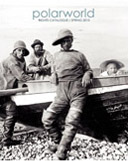 Our ProductsOur Resources |
This website requires the free Flash plugin to be installed.
Polarworld - discover more polar booksThe Arctic Book ReviewResolute: The Epic Search for the Northwest Passage and John Martin Sandler Reviewed by Jonathan Dore Martin Sandler, for the last 35 years the prolific author of popular and school texts on American photography and transportation, and a TV producer of series on US social history, has now applied his well-honed storytelling skills to northern subjects. This year has already seen the publication of his Trapped in Ice (Scholastic, grades 5–8), the story of the near disaster that overcame the Arctic whaling fleet in 1871, and now it is joined in the icy realms by Resolute, a contribution—for adult readers this time—to the crowded marketplace of books on the loss of John Franklin’s 1845 expedition, its background, and the long search for survivors in its aftermath. A prologue paints an entertaining picture of the discovery in 1855 of the abandoned HMS Resolute by James Buddington’s whaling crew, who, confined on board the ghost ship for three days by a storm, dressed up in the uniforms they found, staged mock swordfights, and helped themselves to the officers’ store of wine. Thereafter, the story of the Resolute is an occasional, but by no means central, strand of Sandler’s story, which encompasses the search for Franklin as a whole, from the initial forays of 1848 right through to Frederick Schwatka’s first expedition 30 years later. Sandler has a firm grip of that story and, once underway, he tells it with verve. To any reader knowledgeable about the Franklin search, the energetic pace seems almost breakneck, so much does he compress into so tight a space: at just under 300 pages it is short for its subject, and the thumbnail portraits of each main participant’s background and personality are perhaps too abbreviated to allow them to be established in the reader’s memory. But the hurried pace allows the reader to see the contours of the whole search in one go, helping to give it the coherence—and sense of urgency—of a unified effort. The appendices are a useful addition, including brief biographical notes on the later careers of the main players, some of the Resolute’s construction diagrams, a lengthy excerpt from Franklin’s 1845 sailing orders, and a timeline of the search, which is especially handy for keeping track of events since so many expeditions were underway simultaneously. A large number of colour and black-and-white illustrations enliven the book, which is also illustrated by some attractive maps—though given the centrality of geographical discovery in the story, and the large number of expeditions mentioned, it would have been nice to have more of these—perhaps at the expense of some of the less obviously relevant illustrations. The first half of the 1850s was the period of greatest activity, with at times more than a dozen ships in the search area at once. While Robert McClure ruthlessly pursued his own agenda—and led the first crew to traverse the Northwest Passage as a result—the period was punctuated by two major multi-ship expeditions, the first in 1850–51 led by Horatio Austin, the second in 1852–54 by Edward Belcher. Both were disappointing in their results: Austin was felt to have given up too soon, while Belcher, infamously, abandoned four seaworthy ships in the Arctic rather than face the personal tedium of another winter there. Those four ships included the Resolute, whose captain, Henry Kellett, had organized the rescue of McClure and his men, and who was furious at being ordered to desert his ship. Barely 18 months later, however, Kellett was vindicated and Belcher disgraced by the sudden reappearance of the unmanned Resolute in Baffin Bay, still afloat and serviceable after drifting more than 1,200 miles from its supposedly final resting place. The generosity of shipping magnate Henry Grinnell had already ensured an American contribution to the search in the form of the De Haven and Kane expeditions. Now the US government stepped in to make its own mark by refitting the Resolute and presenting it back to Queen Victoria, a gracious gesture that bore much diplomatic fruit—in the unquantifiable units of public opinion—by the friendly and fraternal feelings it engendered on both sides of the Atlantic. After decommissioning 25 years later, the Resolute’s story had an unexpectedly strange final act, when Victoria ordered some of its timbers to be used to create three desks, the largest and most lavish of which was sent to President Rutherford Hayes; having served most presidents since, it still sits in the Oval Office. Within the limits of his self-imposed brevity, Sandler has done his job on the great search, and on the Resolute, confidently and well. But the book’s first five chapters in particular, which summarize Northwest Passage exploration up to 1845, are unfortunately marred by numerous errors that suggest the limits of the author’s knowledge of the background to his main topic, and an unwise reliance on memory while writing, rather than checking his sources. Henry Hudson discovered the river and the bay named after him on two separate voyages in different years, not both in the voyage of 1609 (note, page 257); Bloody Falls is on the Coppermine River, so Samuel Hearne could not have witnessed the massacre there weeks before reaching the river (note, page 260, contradicted by the main text on page 38); John Ross named the mirage he saw in Lancaster Sound the Croker, not Crocker, Mountains (page 29 and passim; Sandler seems to have confused them with Robert Peary’s equally non-existent “Crocker Land”, north of Ellesmere Island); Franklin was thirty-three when he began his first overland expedition, not twenty-three (page 32), and his Point Turnagain on the Kent Peninsula was not “in an area originally discovered by Captain James Cook in 1778 and later named Turnagain by explorer George Vancouver”, since neither earlier explorer had ever been within 2,000 kilometres of the place (page 40; Cook’s Turnagain River, which Vancouver renamed Turnagain Arm when he discovered it led nowhere, is near Anchorage); Baffin Island’s Admiralty Inlet is 15 miles wide, not long (page 63), and the island was not named by Parry (whose “Baffin Island” was a different, and much smaller, place; note, page 258); the ship that rescued John Ross and the crew of his second voyage was not the Isabella of Hull, but simply the Isabella, from Hull (page 63and 64); Victoria Island is 84,000 square miles in area, not 135,000 square miles (page 82; the latter figure seems to be an attempted conversion to square kilometres, but multiplied by the factor for distance, not area); in the motto Per mare, per terram, per glaciem, the first noun translates as “sea”, not “mud” (page 118); John Richardson was the author of the Fauna Boreali-Americana, but not the Flora, which was the work of William Hooker (page 245); illustration 26 shows not message-carrying balloons, but much larger, man-carrying ones; illustration 27 does not show whalers “at work”, unless their work involved burning their ships down to the waterline… and there are a clutch of merely inadvertent substitutions of the wrong year, compass direction or name. Sadly, quite a few readers unfamiliar with the subject will get hold of the wrong ends of quite a few sticks as a result. Sadder still, the author has been badly let down by his publisher, for on top of the uncorrected errors of fact, which substantive editing and readers’ reports should have cleared up, there are inconsistencies and stylistic infelicities that suggest the text has barely been copy-edited, and numerous typos that indicate an absence even of basic proofreading. No one will need special knowledge to spot these, and publishers who think skimping on their editorial process is a cost-saving exercise are likely to find themselves eventually paying the cost nevertheless. Overall, then, a book that with proper editorial oversight would have been a useful and enjoyable introduction to the Franklin search has been badly compromised. Readers who are familiar with the subject and can spot its mistakes can still find literary pleasure in Resolute, but anyone approaching the subject for the first time would be much better advised to read Pierre Berton’s The Arctic Grail (reprinted by Lyons Press in 2000).
Back to Arctic Book Review
|
|
||
follow us  | join us | join us  | home | contact | home | contact
|
||||
|
© Copyright Polarworld Ltd
SiteWizard.co.uk Web Site Design Company |
||||


